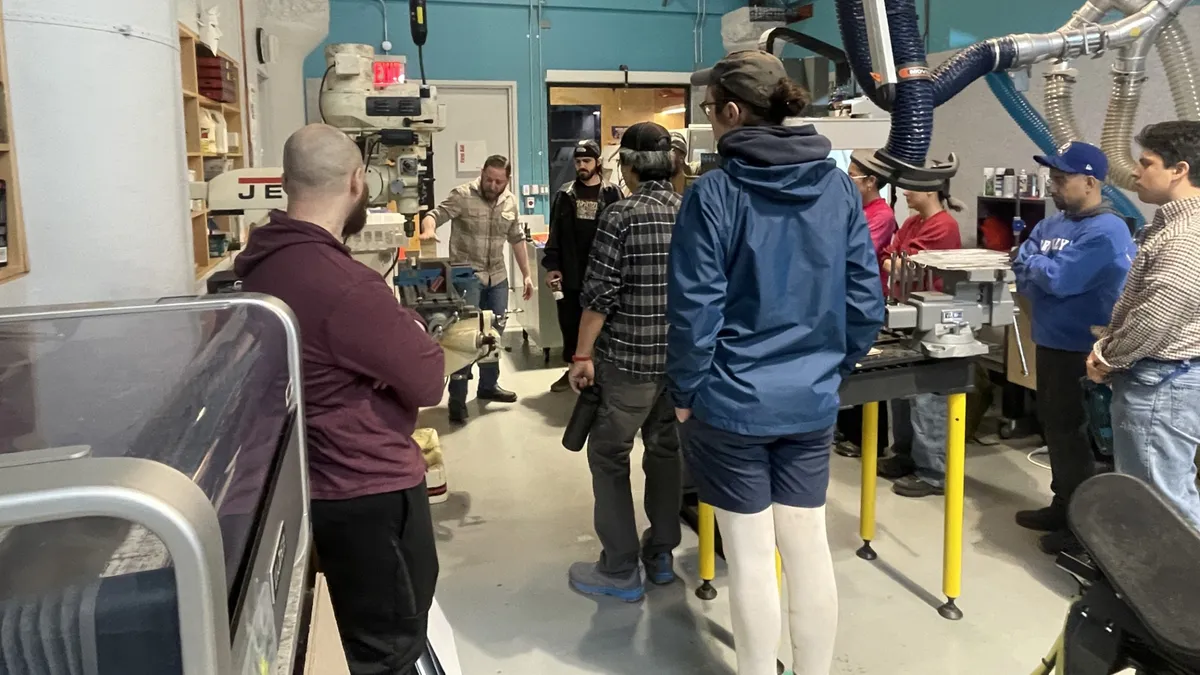Lindsay Greene is president and CEO of the Brooklyn Navy Yard Development Corp.
To meet the consumer demands of tomorrow, we need to empower workers to succeed in the types of satisfying careers dominating today’s digital age, which is why investing in upskilling the current workforce is essential.
Preserving such skilled work that requires real training — but not the kind that comes with traditional degrees — is the foundation of preserving a version of a thriving middle class in the future economy. But this path often requires collaboration from stakeholders and, without a doubt, both the public and private sectors’ involvement.
An example of such collaboration is found in New York City at the Brooklyn Navy Yard, run by the Brooklyn Navy Yard Development Corp.: a workforce training program focused on upskilling manufacturing employees to become computer numerical control machine operators.
The Yard is home to over 13,000 employees working across 550+ businesses, benefitting from the economic development organization’s innovative workforce development initiatives, accessible real estate options and business advancement support. The CNC program provides a great example of public and private stakeholders partnering to improve employment outcomes in an industry at high risk of workforce shortages.
Determine the right job pipeline
CNC technology has become the top production method in the United States and around the globe for all manufacturing businesses today. Chances are very high that the MRI scanner at a local radiology department, or a unique jewelry item, or someone’s favorite piece of furniture were all made with CNC-powered advanced manufacturing. CNC machines are now at the forefront — and middle — of the proverbial assembly line, which means that working in today’s manufacturing economy requires knowing how to work with CNC-based machines.
That’s why the Brooklyn Navy Yard chose to offer CNC training with certifications as a key part of its workforce development programming.
The program complements the Yard’s on-site employment center and workplace-immersion-based technical high school located at the 300-acre waterfront industrial hub, where people are producing goods ranging in specialty from furniture and “sustainable leather” jackets to electric motorcycles and devices that allow quadruple amputees to “type” with their thoughts.
This amazing range of economic activity, and the variety of skills and people working at the Yard, dates to its first origin in the 1800s as the “Can Do” Naval shipyard; not only did the Navy make many “firsts” there, but the hands that made and repaired the ships were more representative of New York City’s diversity than most workplaces. That inclusivity was, and still is, rooted in the core belief that every person who enters the Yard deserves an opportunity to learn a new trade that gives them a lifetime career opportunity.
Fast forward 223 years and that commitment remains a major reason the Yard provides catalytic training opportunities, like its CNC program, to prepare people for careers in the modern green economy taking shape today.
Consider a replication approach
Many “jobs of the future” will require reskilling or training on new devices such as CNC machines, even as those jobs remain accessible ones that do not require extensive degrees. Below are four reasons employers why employers can benefit from reskilling programs.
1. Help a local workforce access emerging opportunities
New York City is home to an unparalleled diverse and expansive talent pool — and that’s why it's home to most Fortune 500 companies. With nearly 440 colleges, universities and trade schools to choose from, it’s one of the nation's top cities for recruitment in various industries. And, as a historical manufacturing hub, it’s still a place where opportunities are made and seized daily.
The Brooklyn Navy Yard is surrounded by an endless talent pool in constant need of new economic opportunities as industry sectors shift and trends impact the existing job market.The Yard has chosen to deliver on this goal by, among other things, providing two types of CNC training, since many advanced manufacturing tenants at the Brooklyn Navy Yard and businesses across New York City increasingly rely on workers with these skills. One program trains and certifies entry-level operators, and the other upskills are already certified specialists with multiple years of experience. Every year, the organization sponsors several 16-week training cohorts that support scores of New Yorkers as they gain new, marketable skills that can help them get jobs at and around the Yard.
2. Increase the wage potential of a local workforce
As a public-sector economic development entity, providing jobs is not the only focus. To keep up with rising costs of living and economic conditions, government non-profit organizations like the Brooklyn Navy Yard Development Corp. also focus on increasing the wages of the represented workforce as well.
One only needs ambition and interest in learning a new skill to earn CNC certification. Nationally averaging anywhere from $15 – 33 an hour, CNC specialists can attain a viable career path that guarantees them economic mobility without higher education degrees. Disadvantaged populations – especially women, people of color and low-income families – have greatly benefited from CNC training and have achieved the credentials to attain higher-wage jobs.
Both training programs offer classroom and hands-on experience with projects executed on real CNC machines so trainees can build competency in critical skills early with instructor support. Also, skill certification testing is embedded throughout the course rather than at the end, ensuring students effectively master compounding skills at each step along the way.
The Yard also developed these programs with scheduling flexibility in mind, so participants don’t lose current income opportunities in the process. The trainings are both part-time and hosted on Saturdays for those who are currently employed, allowing them to participate without risking income loss.
To provide students with genuine hands-on experience, classes are held inside some Yard-based companies with CNC machine shops and at the Brooklyn STEAM Center’s CNC lab, a New York City public school embedded at the Brooklyn Navy Yard site.
3. Help businesses meet growing demand for talent
Investing in local talent development is a critical way for the public sector to strengthen a business ecosystem and improve the bottom line for the private sector businesses that employ them. As the focus shifts to re-shoring key manufacturing sectors, and the unemployment rate continues to tighten, it has never been timelier to invest in the workforce upskilling required for advanced manufacturing.
The Brooklyn Navy Yard’s curriculum was developed through discussions with the tenants and businesses after discovering the need for CNC operators. Tenants benefit by having an on-site training program that creates an accessible talent pool of certified CNC operators and allows their own employees to upskill. The training programs also enable the Yard to tap into new audiences unfamiliar with industrial trades and unaware of the high-quality advanced manufacturing careers available in the city.
Rather than posting a job listing and undergoing an extensive process to find a CNC operator or specialist, Yard-based businesses and other companies can source talent directly through the program. This approach saves time and money for employers while providing workers with meaningful, verified career opportunities.
4. Maintain a global competitive advantage and strengthen local supply chains
If anything was learned following the COVID pandemic, it’s the need to re-shore the manufacturing of certain products needed in times of emergency. Whether it’s personal protective equipment or semiconductors, the United States relied heavily on shipments from other countries for survival and economic stability.
This highlighted the importance of investing in training the workforce for new technology platforms to reinforce urban, advanced manufacturing ecosystems in large consumer markets, thus strengthening our collective workforce and ensuring a more resilient economy.
Many traditional manufacturers are embracing new technologies as they continue to expand throughout the country. This effort can happen more quickly when supported by economic development organizations. Even the federal government has played a role in promoting tech training to fortify local supply chains and empower Americans to achieve economic advancement.
Investing in training programs through public-private partnerships undoubtedly presents a transformative opportunity to boost global competitiveness and expand the workforce readiness for high-demand roles within local economies. The Brooklyn Navy Yard’s CNC trainings model can certainly apply to other sectors and fill other growing workforce gaps in fields like technology, engineering or healthcare.




















